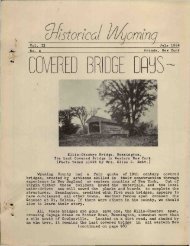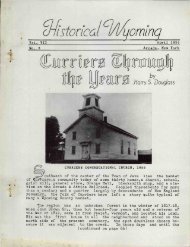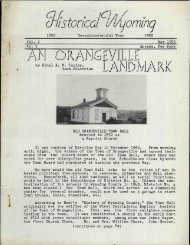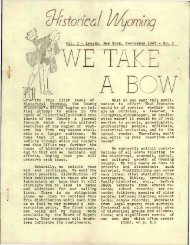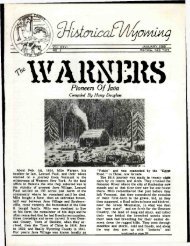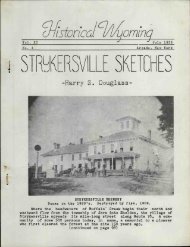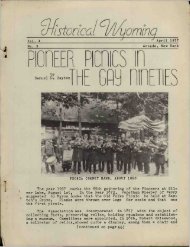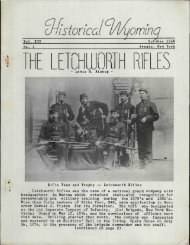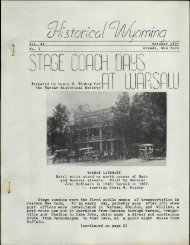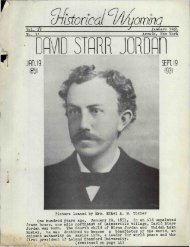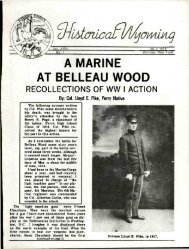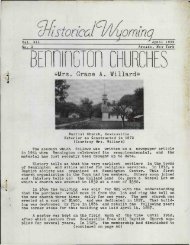By C. Kihm Richardson Walking from Strykersville ... - Fulton History
By C. Kihm Richardson Walking from Strykersville ... - Fulton History
By C. Kihm Richardson Walking from Strykersville ... - Fulton History
Create successful ePaper yourself
Turn your PDF publications into a flip-book with our unique Google optimized e-Paper software.
APRIL 1978<br />
THOUGHTS ON<br />
PIONEER LIVING<br />
AND THE ROLE OF THE<br />
PIONEER WOMAN<br />
...<strong>By</strong> Robert M. French<br />
PROLOGUE<br />
For many years I have marvelled at the hardships<br />
suffered by the early settlers, and particularly<br />
at the work demanded of their wives and daughters<br />
in the early days of Pike and the Holland<br />
Purchase area. One New England author, Alice<br />
Morse Earle, in her "HOME LIFE IN COLONIAL<br />
DAYS" gives us many interesting details of pioneer<br />
living in the places where our settlers originated;<br />
other accounts I relate have come <strong>from</strong> John<br />
Minard of Hume, an Allegany county surveyor, and<br />
<strong>from</strong> Julia Tarbell Merrill's "RUSHFORD CEN-<br />
TENNIAL." I also rely on personal recollections<br />
of stories told by my grandparents.<br />
What the historian Earle recounts, however, is<br />
predicated on a colonial way of life as it was in<br />
Massachusetts about a hundred years after the<br />
arrival of the pilgrims. The soil there had been<br />
cleared around the cabin many years before, so<br />
that in most cases each home had a garden patch<br />
well cultivated for their needs.<br />
EARLY PIKE FAMILIES<br />
Not so for the first settlers of the Holland Purchase.<br />
They had virgin soil to tame, and it was<br />
conceded to be the work of the housewife to do it.<br />
The first housewife in Pike was the wife of<br />
Asahel Newcomb. The Newcombs had at least two<br />
grown children when they arrived, Asahel Jr. and<br />
Susannah. Susannah soon married another early<br />
settler, Eli Griffith. Eli built a log cabin on the<br />
site of Pike's first town hall. Griffith started one<br />
of the first saw mills and also a grist mill. Perhaps<br />
the first in the Holland Purchase. Many were<br />
built about the same time.<br />
The Newcombs lived nearby in a "shanty." (Our<br />
first Pike historian, Carlos Stebbins sketched it<br />
about 1835. This sketch has been mounted and can<br />
be seen in the Pike Library).<br />
FIRST FRAME HOUSE<br />
Perhaps the first Griffith child was born in the<br />
cabin, but Griffith with the aid of his saw mill<br />
erected one of the first planked frame houses in<br />
PAGE 93<br />
Wyoming County Pioneer House built around 1808<br />
by Eli Griffith located at Wyoming County Fair<br />
Grounds. Now in process of restoration.<br />
the Holland Purchase, which still rests on its original<br />
site. This house, being gradually reconstructed<br />
by the Wyoming Fair Association, is now the gateway<br />
to the Wyoming County Fairgrounds. It is a<br />
showplace to recreate pioneer living for the benefit<br />
of thousands of fairgoers every summer. Eli<br />
Griffith later became one of the first judges in<br />
Allegany County. (Pike was in Allegany Co. until<br />
1846).<br />
According to Minard, v "the first settlers in Hume<br />
walked five miles every week to get their bread."<br />
They were bachelors, and had to go to the Griffith<br />
house where Susannah did the baking. It is futile<br />
to speculate whether she could have used a yeast<br />
starter or made salt rising bread. In the absence<br />
of a local brewery, either one required the same<br />
labor. It is probable that it was part rye and part<br />
cornmeal bread. Early wheat plantings did not<br />
always ripen well.<br />
Without doubt the pioneers brought with them<br />
<strong>from</strong> New. England various seeds and probably<br />
seed potatoes. These when planted the first season<br />
insured food for the year ahead also. The settlers<br />
might be thirty miles or more <strong>from</strong> a store or<br />
civilization. After the seeds were planted the<br />
family must wait three months or more for harvest,<br />
meanwhile living on fish and game, Indian<br />
fashion.<br />
The garden was in a clearing close to the house.<br />
Women, as a rule, had a minor role in clearing<br />
the land, but my great grandmother, Clarissa Lord<br />
Thornton, often pulled one end of a two-man<br />
cross-cut saw when other males were unavailable.<br />
There were "log-rollings" often at one farm or<br />
another, at which time neighborhood women got<br />
together for chats and served communal meals.<br />
Kettles were hung on cranes in the open fireplace,<br />
such as the one you can see at Fair-time<br />
in the old Griffith house. When apples were avail-<br />
(continued on page 94)



